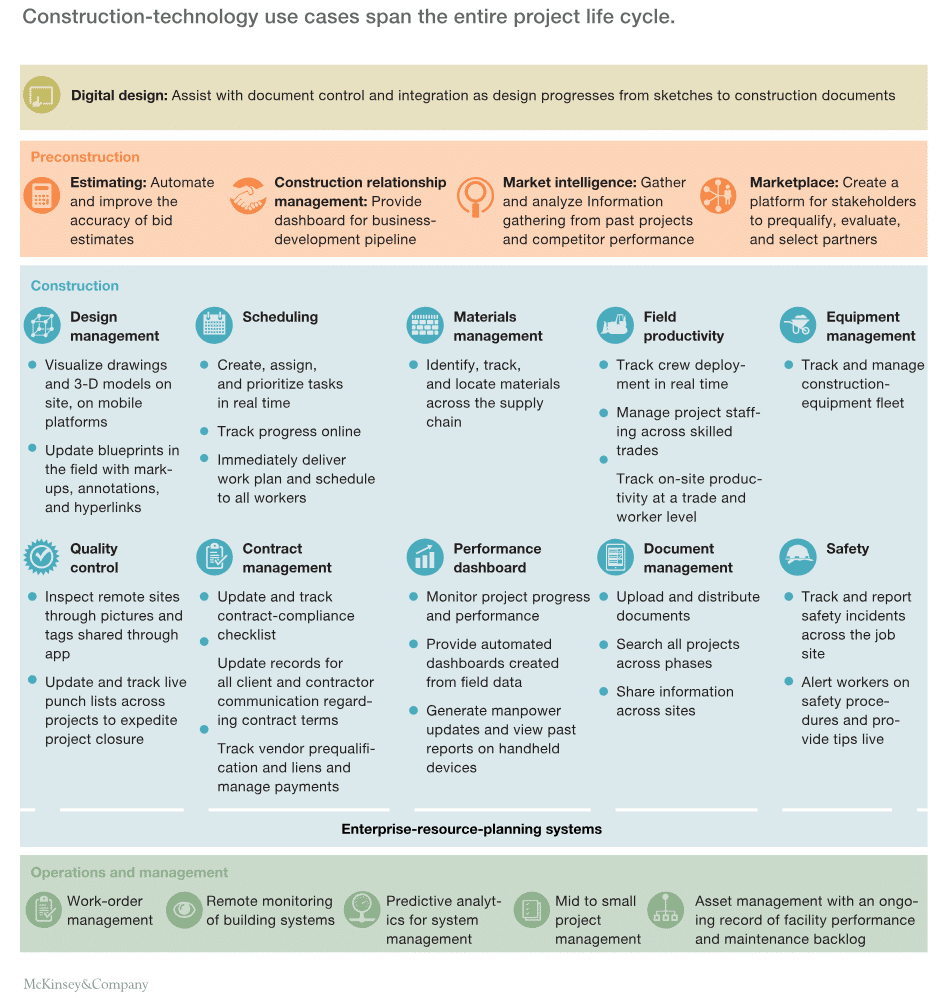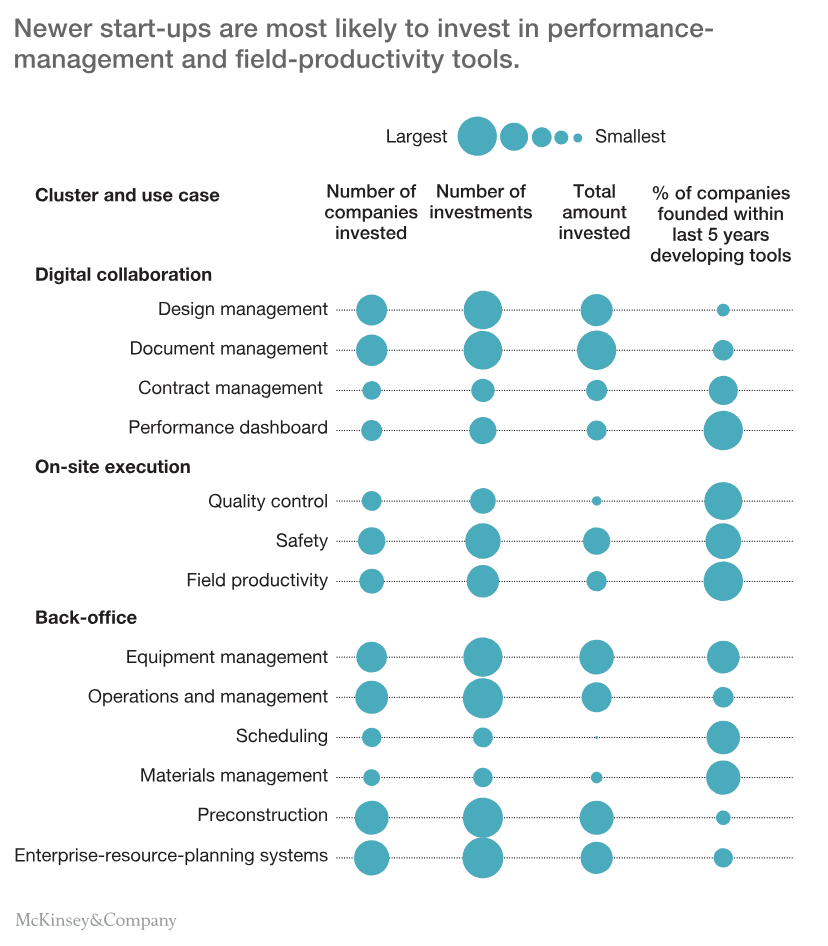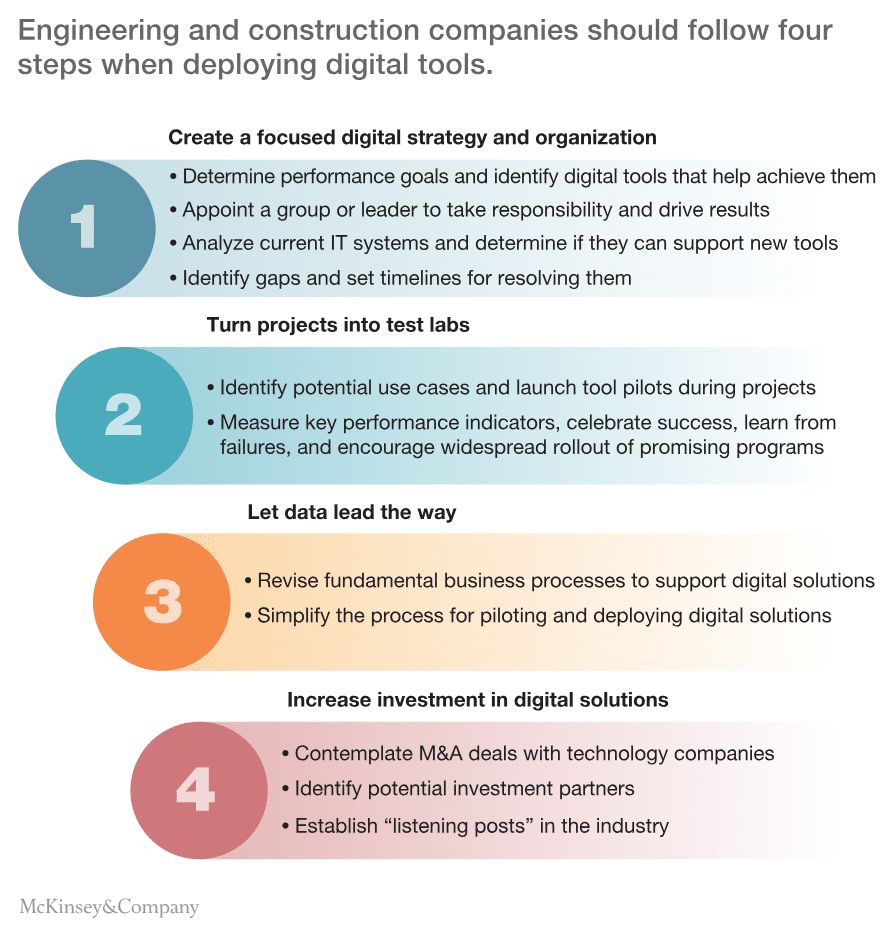McKinsey & Company published recently a very informative report in regard to the new era that emerges both in engineering and construction technology. It is no secret that digital technologies are taking the building sector.
We are on the verge of a substantial paradigm shift which is fueled by the appearance of innovative construction technology startups and their effort to build new tools and applications which will eventually transform the way companies design, schedule and operate on projects.
At the moment, the engineering and construction sector is under extreme pressure due to the continuously increased perplexity and cost of construction projects. As a result, project managers are in a very tough spot as they constantly try to boost efficiency, minimise costs and improve timelines.
This is where cutting-edge tech startups enter the game and try to help through the creation of smart construction hardware, advanced software and by providing a more analytical approach to the whole construction process.
What does the construction industry look like today?
The rising of a powerful data ecosystem is on its way and it will, in the end, lead to a more collective and collaborative approach in construction. The presence of digital solutions has become much more noticeable during the last years.
According to McKinsey & Company, that’s because engineering and construction companies have increased their efforts to embrace construction technologies and turn them into an integral part of their daily working practices. What is interesting, though, has to do with the fact that the vast majority of their efforts focus on software solutions that set digital collaboration as their main priority.
The reasons behind this narrow approach could be summarised to the following:
- The hesitation of some players to expand further, as the deployment of new tools can be challenging.
- The small returns that they have seen until now in terms of productivity.
- Some of these tools might require a costly investment.
- A good number of companies seem to be digitally immature and hence unfamiliar with an expansion of this type.
An introduction to the McKinsey & Company study
In an effort to make software selection simpler for engineering and construction firms, McKinsey & Company conducted a detailed analysis of 1,000+ construction software startups and the services that they provide.
During the process, they identified the stages of a construction project for which software solutions are mainly made (e.g. design, construction, operations and management, safety monitoring, etc).
Read also: There is a $1.6tn opportunity for construction
Another crucial parameter was the examination of investment patterns among construction companies. In that way, they could determine which type of tools are expected to take over the industry in the upcoming years.
Nevertheless, the main focus of the study was on the tools and solutions implemented in the construction phase of the project, as it is probably the most demanding and complicated part of the engineering and construction process.
McKinsey’s Construction Productivity Survey was also taken into consideration during the creation of the report due to its informative feedback on the common obstacles that construction companies face in regard to digital adoption.
A construction technology revolution at full speed
In the course of the last seven years (2011-2017), construction technology companies have managed to gather $10 bn in investment funding. That’s a significantly high number which proves emphatically that there is a strong momentum for construction software startups.
In the following graph, you can see the numerous types of digital tools that have been created in order to for construction firms to build smarter and more efficient. Next to each solution, you can find how it can contribute to the smooth completion of a project:

- Source: McKinsey & Company
The construction phase under the spotlight
As suggested by the table above, digital tools vastly focus on the construction phase. More than 1,000 contech firms are developing solutions for this project stage, and there are 11 major categories in which they could be divided into.
To the contrary, there is a maximum of 200 firms that build software for other parts of the construction process, such as the design, pre-construction, and management phases.
The use cases listed could be categorised into three primary groups:
- On-site execution
- Digital collaboration
- Back-office integration
Interestingly enough, there are many construction software startups that develop solutions that can serve more than one purposes within the same group. However, only 13% of them is preparing tools that apply to more than one use case cluster.
A digital breakdown of the construction phase
As reported by McKinsey, it becomes evident that many digital solutions have been created for the construction phase. Below you can find a detailed analysis on what they can offer depending on the construction phase group they belong:
On-site execution
The first group includes use cases that have to do with one of the most crucial areas of a construction project: on-site execution. As a rule, engineering and construction companies come across numerous obstacles at this stage. Some of these problems could be high rework rates, poor productivity, and problems with delivering the necessary materials on time.
On-site execution is an area that construction technology startups have heavily touched upon. Through the development of reliable tools, the contech players try to solve some of the most crucial problems for the industry:
- Field productivity: At the moment, there are tools which can help construction firms with boosting productivity on site. Keeping track of the hours that on-site personnel is actively working and monitoring the levels of productivity on the field are only a few examples. The data is originated either from wearable GPS devices or from the workers per se. The best of all is that these updates can be submitted in real-time. Like that, project managers can stay on top of the on-site project progress.
- Safety monitoring: Safety is a major priority for engineering and construction companies. There are many tools today which help with submitting safety warnings and effortlessly report or track any safety breaches.
- Quality control: Inspection is another substantial aspect of every construction project. Thanks to some new digital tools, remote site inspections are now a possibility. Furthermore, the advent of artificial intelligence is expected to enable the creation of autonomous systems of quality control.
Digital collaboration
In the course of a construction project, there are numerous stakeholders that need to come together and collaborate effectively in order for the desired outcome to be achieved. That’s not always easy, though, and this is why many construction software startups have focused their efforts on connecting the construction office to the field in a smart and easy way.
In a nutshell, here are some of the most common challenges that digital tools try to resolve in regard to project management collaboration:
- Design management: Blueprints and every type of project documents can now be updated while on the field. In that manner, project staff can save time and effort. What is more, updates can be sent to all project parties in real-time.
- Contract management: Tools that focus on contract management can be extremely helpful, too. They can be used for updating punch lists and examining the compliance of the project tasks to the signed contract.
- Performance management: Thanks to performance management solutions, construction managers can send and receive real-time updates while on site. The data collection process is simplified to great extent and the monitoring of the whole process becomes much easier.
- Document management: Construction projects can get very messy when it comes to document management. For that reason, there is a vast number of digital solutions that have been created in order to take good care of this project aspect. Uploading new documents, updating existing ones and notifying project members for the latest changes are some of the features that contech startups are working on.
Back-office integration
A construction project doesn’t concern only what’s happening on site. The back-office has an indispensable role during the whole process, as well. This is where some of the most essential parameters of the project, such as finance, accounting, and human resources are taken care of.
During such tasks, the collection and proper exploitation of project-related data are fundamental. Construction technology startups managed to detect this gap in the market and build digital solutions which could add more precision to the whole process.
The real-time access to the back-office can also provide people on site with tremendous help. Foremen can effortlessly, for example, monitor the progress of the different orders and receive updates about them in real-time. In a sentence, we are talking about a building process where all its components are harmoniously connected with each other.
Field-productivity and performance-management tools gain momentum
McKinsey’s report continues with a detailed analysis of the digital tools that have a momentum in the industry. Construction technology startups which focus on field-productivity and performance-management seem to attract most of the attention at the moment.
This tendency has started becoming visible during the last five years. More specifically, 29% of the companies which develop contech solutions focus on one of those two project areas. By contrast, only 8% of the companies choose to develop document-management solutions.
These stats attract even more interest if we take into account that McKinsey had identified field-productivity and performance-management as the two most problematic aspects of the building process. In simple words, this ongoing shift is very promising for the sector’s future.
In the graph below, made by McKinsey & Company, you can take a closer look at the different areas where construction technology startups prefer to invest in:

- Source: McKinsey & Company
Software and hardware collaboration
We already referred to the creation of a new data ecosystem that will be founded on mutually beneficial partnerships within the sector. Large-scale equipment players and construction technology firms are establishing partnerships wthatcan empower the beginning of a digital era in engineering and construction.
McKinsey’s research has spotted some representative examples to that direction:
- Predictive analytics: It is no news that construction projects generate vast amounts of data. Construction companies have the responsibility to collect, store and make good use of this data. If used correctly, these bits of information can help them to build more efficiently and avoid costly mistakes and delays in future projects. For this to happen, though, both engineering and construction firms should invest in smart hardware and/or software which would allow the better categorisation of the gathered data.
- Project monitoring via drones and IoT: Drone and IoT technologies can help significantly with the 5D BIM process. In other words, they can facilitate the digital mapping and recreation of physical structures and then analyse it in conjunction with scheduling and cost information. The examination of the on-site equipment and its timely maintenance can also make a difference.
- Safety monitoring via wearable or augmented reality: Safety is always one of the biggest concerns for construction companies. With that in mind, it is no surprise that many firms have already started deploying safety solutions which rely on wearable technology or augmented reality. Skanska and Redpoint Positioning are two excellent examples as they have marked hazardous indoor zones with the help of GPS technology. Every time their employees approach a designated area, they will receive a warning notification on their smartphone. Virtual safety tours are also part of this group of solutions.
Why the deployment of construction technology can be hard
During the last decade, engineering and construction companies have implemented a good number of digital solutions. Nevertheless, many of them still battle against significant problems when it comes down to deploying these tools in the company’s working routine. This can either be due to the digital immaturity of the firm or the fact that the new tools don’t generate any noticeable results.
In short, some of the biggest obstacles in deploying construction technology at engineering and construction firms could be summed up to the following:
- Inadequate commitment: In some cases, construction companies fail to remain consistent in their effort to implement digital tools properly. Going back to old, inefficient habits is always a danger.
- Problems with pushing for company-wide adoption: The resistance of some employees to adopt the use of new tools can also be a problem. Learning to work in a different way than the one you are used to is always challenging and without the proper motivation, many employees may not find the reason to change their working practices.
- Lack of compatibility: Being part of a strongly connected data ecosystem is of paramount importance for the smooth deployment of a digital solution. A tool that isn’t able to integrate will eventually be led out of business due to its impractical nature.
It becomes evident, then, that deploying construction technology can be very challenging. A strong and fresh perspective is required for this substantial paradigm shift to work. McKinsey & Company describes this plan as a next-generation operating model which consists of the following components:
- Extra attention on the client journey: Focus on improving the entire client journey instead of specific functions.
- A full set of digital levers: Implementing a combination of different digital solutions can provide greater results than only focusing on certain aspects of the process.
- A new management system: A fresh management systems with additional incentives and data-enabled transparency can accelerate the digital adoption process.
- A cultural shift: A focus on increasing digital maturity among the employees of the firm can contribute to the faster deployment of digital technologies.
Four crucial steps when deploying digital tools
The creation and implementation of a next-generation operating model can be a major challenge for many construction companies. Especially if we take into consideration the fact that they have already put in place certain strategies in order to deal with recurring problems that they face across numerous projects. In such situations, it can be even harder for an organisation to change its approach.
In an effort to help engineering and construction firms with this nightmare, McKinsey suggests the adoption of four critical steps which you can see on the following graph:

- Source: McKinsey & Company
LetsBuild as part of the cultural shift
The construction industry is a $10 trillion giant who at the moment undergoes a vital cultural transformation. Construction technology startups should take an active part in this process and help the innovative players of the sector enter the new era with as smoothly as possible.
‘McKinsey does an excellent job in explaining why it’s important to communicate and align frequently. Minor modifications to resources, project planning, orders could drastically increase costs and timelines if made late in the game’, says Jason Ruddle, UK MD at LetsBuild.
And he adds:
‘The adoption of digital solutions is paramount to the future of the construction industry. Today many companies use every technology advantage to move towards a digital construction industry, from electronic communication and collaboration through to using advanced software to manage the building process. Digital construction is rapidly changing the relationship that construction companies have with information, making it more central to the business and to decision-making’.
In LetsBuild we are well aware of our responsibility to drive change through our consistent focus on collecting and distributing data and insight across the teams. Establishing strategic partnerships with other innovative players of our industry brings us a step closer to our goal of becoming the digital backbone of the building process. In that way, we can help construction companies become more effective, agile and digital mature.




